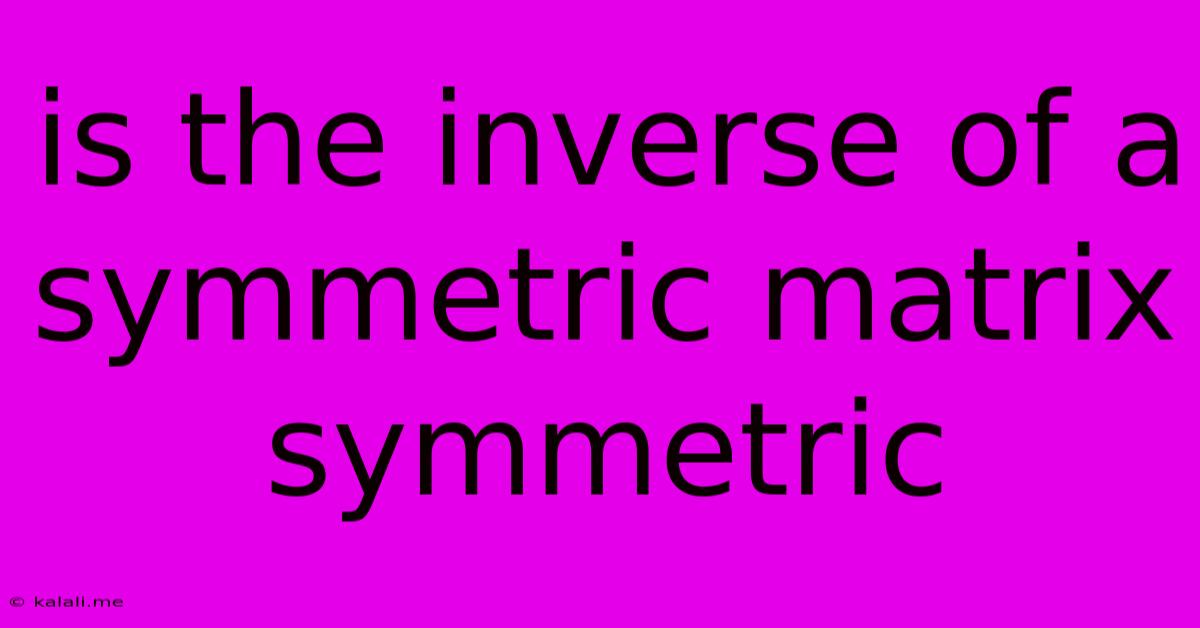Is The Inverse Of A Symmetric Matrix Symmetric
Kalali
May 28, 2025 · 3 min read

Table of Contents
Is the Inverse of a Symmetric Matrix Symmetric?
The question of whether the inverse of a symmetric matrix is also symmetric is a common one in linear algebra. The short answer is yes, provided the inverse exists. This article will delve into why this is true, exploring the underlying mathematical principles and providing a clear explanation. Understanding this property is crucial for various applications, from solving systems of linear equations to working with covariance matrices in statistics.
The key to understanding this lies in the definition of a symmetric matrix and the properties of matrix inverses. A matrix is considered symmetric if it's equal to its transpose; that is, A = A<sup>T</sup>. The transpose of a matrix is obtained by swapping its rows and columns. The inverse of a matrix A, denoted as A<sup>-1</sup>, satisfies the condition A * A<sup>-1</sup> = I, where I is the identity matrix.
Proving the Symmetry of the Inverse
Let's assume A is a symmetric matrix (A = A<sup>T</sup>) and that its inverse, A<sup>-1</sup>, exists. To prove that A<sup>-1</sup> is also symmetric, we need to show that (A<sup>-1</sup>)<sup>T</sup> = A<sup>-1</sup>. We can do this using the following steps:
-
Start with the defining property of the inverse: A * A<sup>-1</sup> = I
-
Take the transpose of both sides: (A * A<sup>-1</sup>)<sup>T</sup> = I<sup>T</sup>
-
Use the property that (AB)<sup>T</sup> = B<sup>T</sup>A<sup>T</sup>: (A<sup>-1</sup>)<sup>T</sup> * A<sup>T</sup> = I (Note that the transpose of the identity matrix is itself)
-
Substitute A for A<sup>T</sup> (since A is symmetric): (A<sup>-1</sup>)<sup>T</sup> * A = I
-
Multiply both sides by A<sup>-1</sup> on the right: (A<sup>-1</sup>)<sup>T</sup> * A * A<sup>-1</sup> = I * A<sup>-1</sup>
-
Simplify using the property of the inverse: (A<sup>-1</sup>)<sup>T</sup> * I = A<sup>-1</sup>
-
Finally, we arrive at: (A<sup>-1</sup>)<sup>T</sup> = A<sup>-1</sup>
This conclusively demonstrates that the transpose of the inverse of a symmetric matrix is equal to its inverse, proving that the inverse is also symmetric.
Implications and Applications
This seemingly simple property has significant implications across various fields. For instance, in statistics, covariance matrices are always symmetric. Knowing that their inverses (often used in multivariate analysis) are also symmetric simplifies calculations and interpretations. Similarly, in physics and engineering, numerous problems involve symmetric matrices, and the knowledge that their inverses retain this symmetry simplifies the analysis of the resulting systems.
In summary: The inverse of a symmetric matrix, if it exists, is always symmetric. This property stems directly from the definition of symmetry and the properties of matrix transposition and inversion. Understanding this fundamental principle is essential for anyone working with matrices in a variety of mathematical and scientific contexts.
Latest Posts
Latest Posts
-
Gaussian Mixture Distribution Em Update Graphs
May 30, 2025
-
Please Let Me Know If These Are Sufficient
May 30, 2025
-
Is It Possible To Steal Things In Witcher 3
May 30, 2025
-
What Does It Mean To Take Up Your Cross
May 30, 2025
-
How To Remove Oil From Cement
May 30, 2025
Related Post
Thank you for visiting our website which covers about Is The Inverse Of A Symmetric Matrix Symmetric . We hope the information provided has been useful to you. Feel free to contact us if you have any questions or need further assistance. See you next time and don't miss to bookmark.